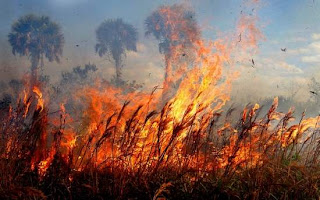I don't think I saw a speck of snow until I drove up our driveway. We have several piles, remnants of our plower's work. One of them is quite enormous, but as I recall, there was still a fairly good supply of compost under there. I shall be optimistic and believe that it's mostly soil.
I will tend to this soon. When it's not so damn cold. And wet. In oh, about a month.
Various heaths, the white one in brave full bloom, and the red one...just plain joyfully outrageous, surrounded as it is by bleakness and woe. Sorry the picture of the red one (Winter Chocolate?) is so poor, I'll try to do better.
I grow them here, where it goes below -10 from time to time, without reliable snow cover and in a very exposed southwestern exposure. They survived the worst winter ever, a few years ago ('06? I am not a journal keeper. No, this blog does not qualify). What is the secret? I have no idea. Heath-loving gremlins. I have also lost some.
Customers will ask why one of a particular plant has died, when the other(s) has not. They seem to imagine that gardening is a precise science.
Another plant that I find gratifying at this time of year is the Sedum Angelique:
As is this fine specimen:  Ajuga 'Chocolate Chip'. Looks like total yuck at the moment, but soon it will regain its bronzy tones and burst forth with cobalt blue blooms. I'd grow it even if it didn't flower; in fact, I'd probably prefer it that way. I use it between stepping stones and it takes plenty of abuse - foot traffic (human and large bouncy dogs) and occasional dog pee (our dogs are generally very well behaved but they have their moments). Another groundcover - I find groundcovering plants more and more useful (not to mention cost-effective). My favorite favorite book on groundcover plants is Perennial Groundcovers by David MacKenzie. This book will help move you beyond your vinca/pachysandra phase, if you're still stuck back there.
Ajuga 'Chocolate Chip'. Looks like total yuck at the moment, but soon it will regain its bronzy tones and burst forth with cobalt blue blooms. I'd grow it even if it didn't flower; in fact, I'd probably prefer it that way. I use it between stepping stones and it takes plenty of abuse - foot traffic (human and large bouncy dogs) and occasional dog pee (our dogs are generally very well behaved but they have their moments). Another groundcover - I find groundcovering plants more and more useful (not to mention cost-effective). My favorite favorite book on groundcover plants is Perennial Groundcovers by David MacKenzie. This book will help move you beyond your vinca/pachysandra phase, if you're still stuck back there.


 ....and for cleaning out your car.
....and for cleaning out your car.




